| Pages:
1
..
11
12
13
14
15
..
25 |
Formatik
National Hazard
   
Posts: 927
Registered: 25-3-2008
Member Is Offline
Mood: equilibrium
|
|
Engager was quite modest initially when talking about its sensitivity, but he's an expert who knows how to handle it. Also Engager's great work, Energetic derivatives of tetrazole, in the prepublication section describes the compound a bit more. Some
answers to your questions can also be found in my previously mentioned commentary:
Characterization of some tetrazole compounds:
http://www.sciencemadness.org/talk/files.php?pid=225372&...
(again, ignore comments on mercury diazoaminotetrazolate's power)
CuNT is as indicated very impact and friction sensitive. In fact, Klapoetke has said it appears to be more impact sensitive than lead azide. I agree.
Hammer blows aren't needed. A pestle weighing a few grams falling from a few centimeters on some crystals can detonate it.
I don't know about dead pressing, and I'm not sure on long term storage. I wouldn't chance it. What if a large crystal forms?
I think you've made too much of a compound you know very little about, especially a primary. I would recommend to dispose of it. Nitrotetrazoles are
primaries on steroids. Milligrams can blow off fingers, the amount you made can blow up rooms.
[Edited on 6-7-2012 by Formatik]
|
|
|
fenolazul
Harmless

Posts: 4
Registered: 28-6-2012
Member Is Offline
Mood: No Mood
|
|
By its nature acidic (Ph about 2), once synthesized Copper (II) nitrotetrazolate (CuC3HN15O6.(H2O)n, CuNTZ), storing wet and in permanent contact with
distilled water, this primary explosive it is stable for long periods of time, even years?
...or for long periods in closed containers and always wet can be decomposed by itself and cause an accidental detonation? 
What if WET forms a crystal or large particles? can break safely?
Someone else can make your experience? Perhaps (as noted Formatik) I have synthesized in house too much product and now I'm nervous and
restless.
[Edited on 7-7-2012 by fenolazul]
|
|
|
Formatik
National Hazard
   
Posts: 927
Registered: 25-3-2008
Member Is Offline
Mood: equilibrium
|
|
The compound should make you nervous. If it doesn't you are doing something wrong.
I would think it is stable longterm. Again, I don't know for sure. But that's not really my big concern with storage. Lead azide, if it forms large
crystals these could detonate. Considering the material is more sensitive than lead azide, if this were to form a large crystal on storage it could be
worse. This can manifest a spontaneous detonation through internal crystalline stress or by mechanical breaking. But, I don't know enough about this
material to tell you whether it does this or not.
Cupric nitrotetrazolate is not really a type of material that is stored from what I gather, it is used as an intermediate for other energetics
(especially initiators which are less sensitive and better). In that process it is kept wet to reduce sensitivity. It is typically converted to sodium
nitrotetrazolate which is also insensitive to hammer blows as a regular hydrate (might still have some static hazard).
|
|
|
fenolazul
Harmless

Posts: 4
Registered: 28-6-2012
Member Is Offline
Mood: No Mood
|
|
Quote: Originally posted by Formatik  | | I would think it is stable longterm. Again, I don't know for sure. Cupric nitrotetrazolate is not really a type of material that is stored from what I
gather, it is used as an intermediate for other energetics (especially initiators which are less sensitive and better). |
@Formatik:
here more pictures of acid salt CuNTZ primary explosive and precursor. With the sincere hope that those experts who have made this
thread (Engager, Rosco Bodine, The Davster, PHILOU Zrealone, Hokk, Sobrero, Microteck, Chemoleo, User, Franklyn, Swany, JohnWW, Nick F, oket, hokk,
quick silver, 497, Pdb, Ritter, Axt, and long etc...) as soon as possible they clarify our doubts concerning to properties, storage, safety and
handling of this potent compound, in dry and wet form.
I hope, Formatik... 
NOTE: Ph around 3 Ok?
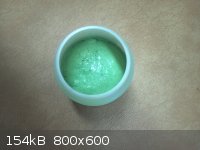 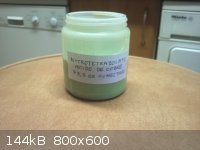 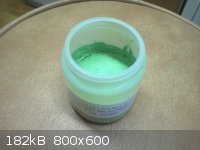 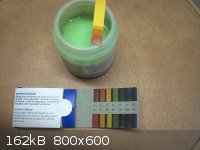 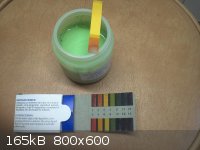
[Edited on 8-7-2012 by fenolazul]
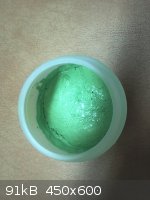
[Edited on 8-7-2012 by fenolazul]
|
|
|
pdb
Hazard to Self
 
Posts: 80
Registered: 8-4-2004
Member Is Offline
Mood: No Mood
|
|
As a basic rule, you should never concentrate more than 1 gr or less of any primary in the same place, and avoid keeping it for years. Your 73 gr
storage, whether dry or moist, is insane.
As CuNT is not widely used, do not expect to find as much information in literature as with century(ies)-known compounds like MF and LA. However, if
you die from your 73 gr, it will be a valuable piece of information (in fact a confirmation of the rule) for the community...
|
|
|
Nick F
Hazard to Others
  
Posts: 439
Registered: 7-9-2002
Member Is Offline
Mood: No Mood
|
|
I think if I were you I would add it slowly to a dilute sodium hydroxide solution. This would form a dilute sodium nitrotetrazole solution, which
should be fine in storage, and copper oxide which can be filtered off. And then use your sodium nitrotetrazole solution to ppte silver nitrotetrazole
or whatever in small quantities as you need it.
|
|
|
The_Davster
A pnictogen
      
Posts: 2861
Registered: 18-11-2003
Member Is Offline
Mood: .
|
|
Just remember, it is far less painful for everyone involved to handle wet CuNT instead of dry.
 
|
|
|
liquidlightning
Hazard to Self
 
Posts: 66
Registered: 10-5-2012
Location: Washington
Member Is Offline
Mood: Witty
|
|
Har har, I see what you did there. And fenolazul, be very careful. Scares me just thinking of storing that much prim explosive.
|
|
|
Boffis
International Hazard
    
Posts: 1867
Registered: 1-5-2011
Member Is Offline
Mood: No Mood
|
|
More investigation into guanidine-nitrous acid
In a series of earlier posts to this thread (October 2011 or there abouts) I investigated a published claim that guanidine reacts with nitrous acid to
give 5-aminotetrazole. A series of experiments however, demonstrated fairly conclusively that this was not the case though unidentified white or
creamy yellow products did resulted. At the time these products were fully investigated though there was some evidence that nitrosoguanidine was
present in the products.
Since then I have been able to investigate the product further and following careful recrystallization I have managed to isolate three identifiable
substances and investigate them. It has not been possible to measure the amount of each compound produced in each experiment because of the amount
“lost” to the mother liquor during crystallization. However, it is now clear that in a weakly acid solution acidified with acetic acid that the
main products are nitrosoguanidine and surprisingly nitroguanidine. The presence of the former has been reported before from a similar reaction in
dilute sulphuric acid but the presence of the later was not expected. It is worth noting that this compound was most abundant in solution that had
stood for 4 or 5 days suggesting that it forms slowly probably by oxidation of the nitrosoguanidine by excess nitrous acid/nitrogen oxides.
In the more acid solutions containing free hydrochloric acid the main product appears to be urea in spite of earlier tests such as hydrolysis to
ammonia indicating that it was absent. A little nitrosoguanidine was present causing the yellowish tint to the product and a possibly a trace of
nitroguanidine.
An ammoniacal solution of nickel acetate gave a red precipitate with the nitrosoguanidine but the reaction products from some experiments, though
yellow, only gave a brown precipitate. The amount of brown precipitate was too small to separate from the filter paper and investigate so it is not
clear whether this is due to the presence of yet another product or simply nickel III oxide hydrate. No cyanamide or is dimer dicyandiamide could be
detected in any of the solid products.
The nitroguanidine and nitrosoguanidine were compared to samples of these products prepared from guanidine nitrate via sulphuric acid dehydration and
reduction of part of the resulting nitroguanidine to the nitroso compound with zinc dust and ammonium chloride, both syntheses are described elsewhere
in this and related threads.
During the coarse of this work I attempted the synthesis of 5 aminotetrazole by my preferred route from cyanoguanidine and Na azide but decided to try
a modification whereby the solid azide was not isolated but generated as an aqueous solution and used direct. The reaction failed but it did generate
an interesting orange red product. I report back on this one with some photographs shortly.
|
|
|
Boffis
International Hazard
    
Posts: 1867
Registered: 1-5-2011
Member Is Offline
Mood: No Mood
|
|
Not 5-aminotetrazole either
I have used the method of producing 5-aminotetrazole outlined in US patent 5451682 on several occasions with complete success. This preparation
involves the reaction of sodium azide with dicyandiamide in the presence of boric acid. While dicyandiamide is not easily obtained it can be purchased
of the internet freely and cheaply. The same is not true of sodium azide which is hard to obtain and expensive and for most amateurs must be
synthesized. There are several methods of preparing alkali azide but the most widely used synthesis is to react hydrazine with an alkyl nitrite in the
presence of sodium hydroxide. There are several variations on the basic synthesis but obtaining solid sodium or potassium azide is always tedious and
it would be helpful if the isolation of the solid could be avoided, in part because the reaction could then be carried out in and aqueous medium
instead of an alcoholic one.
It is reported in an English patent that if a lead salt is added to a mixture of hydrazine nitrate and sodium nitrite lead azide is precipitated.
Since no lead is to be introduced into the preparation of aminotetrazole the more readily available hydrazine sulphate was used in this experiment.
The product in this case should be hydrazoic acid and sodium hydrogen sulphate:
N2H4.H2SO4 + NaNO2 = HN3 + NaHSO4 + 2H2O
Since hydrazoic acid is not a strong acid the presence of a large amount of bisulphate salt may cause loss of highly poisonous hydrogen azide gas from
the solution during manipulation so that after mixing the reaction mixture is neutralised with two molar equivalents of sodium hydroxide. It was
decided to add half the sodium hydroxide at the beginning to liberate free hydrazine.
The ultimate goal is to use the resulting solution directly in the preparation of 5-aminotetrazole.
Experimental
Stir 26.01g of hydrazine sulphate into 175ml of water and add 20ml of 10M sodium hydroxide solution and slowly add to the clear solution 13.80g of
sodium nitrite in 20ml of water. The remaining half of the sodium hydroxide was not added as the solution did not appear particularly acid.
The solution produce above was placed in a 500ml round bottom flask along with 33.4g of dicyandiamide (cyanoguanidine) and 18.56g of boric acid. The
mixture was warmed and swirled around until most of the dicyandiamide had dissolved, a piece of broken porcelain added and the flask then placed in a
heating mantle with a reflux condenser attached. The mixture was heating until boiling and then refluxed gently for 23 hours, yielding a pale yellow
liquid.
After refluxing the solution was poured into a 1 L beaker and acidified with 60ml of 28-30% hydrochloric acid, the red orange precipitate that formed
was filtered at the pump. The precipitate is fine, filtered slowly and difficult to wash and dried after only limited washing. The dried material was
re-dispersed into water filtered heated to 70°C, cooled to room temperature, filtered and dried. The yield of a bright orange red amorphous powder
was 8.57g. It is clearly not 5-aminotetrazole. The compound is insoluble in cold water, alcohol, isopropanol, toluene and dichloromethane, it is very
slightly soluble in boil water and separates out on cooling as a fine red powder. It is soluble in sodium hydroxide forming a dark brown solution that
precipitates a brown amorphous product when acidified. It is weakly energetic when heated above its melting point.
The product has not yet been investigated but its weakly energetic nature and its deep orange red colour suggest an azo compound of the nature of
azo-bis-formamide H2N.C=O.N=N.C=O.NH2.
The cause of the unexpected reaction product may be the failure to completely neutralise the original azide solution which meant in effect the
solution was boiled far too long and any tetrazole derivative that might have formed was decomposed or it may have been due to the presence of
unreacted hydrazine and nitrite in the starting mixture. Further experiments will be conducted when time permits using the following modification:
After mixing the hydrazine salt and sodium nitrite raise the temperature to a gentle reflux very briefly and cool.
Completely neutralise the solution completely as was originally intended before adding the cyanoguanidine and boric acid. Alternatively the
boric acid can be omitted and the reaction mixture refluxed for a short period of time.
I have just purchased some melting point apparatus off ebay so when I get it working I'll investigate the m.p.'s of this and the products described in
the previous post.
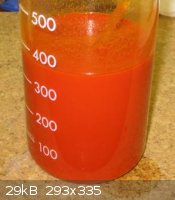 Precipitate on acidifying with HCl Precipitate on acidifying with HCl
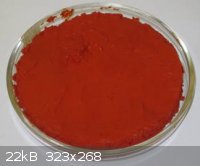 Final product still moist after 2nd filtration Final product still moist after 2nd filtration
[Edited on 7-10-2012 by Boffis]
[Edited on 7-10-2012 by Boffis]
|
|
|
PHILOU Zrealone
International Hazard
    
Posts: 2893
Registered: 20-5-2002
Location: Brussel
Member Is Offline
Mood: Bis-diazo-dinitro-hydroquinonic
|
|
Quote: Originally posted by Nick F  | I think if I were you I would add it slowly to a dilute sodium hydroxide solution. This would form a dilute sodium nitrotetrazole solution, which
should be fine in storage, and copper oxide which can be filtered off. And then use your sodium nitrotetrazole solution to ppte silver nitrotetrazole
or whatever in small quantities as you need it.
|
Nice idea.
Although if you put Na hydroxyde in the mix, the hydroxyde will not turn into oxyde. You will get turquoise blue Cu (II) hydroxyde precipitate and not
the black Cu (II) oxyde.
Cu(NTZ)2 (s) + 2NaOH --> Cu(OH)2 (s) + 2 NaNTZ
Sole problem, both the precipitates Cu(NTZ)2 and Cu(OH)2 will almost look the same color...
[Edited on 22-10-2012 by PHILOU Zrealone]
PH Z (PHILOU Zrealone)
"Physic is all what never works; Chemistry is all what stinks and explodes!"-"Life that deadly disease, sexually transmitted."(W.Allen)
|
|
|
The_Davster
A pnictogen
      
Posts: 2861
Registered: 18-11-2003
Member Is Offline
Mood: .
|
|
Quote: Originally posted by PHILOU Zrealone  | Quote: Originally posted by Nick F  | I think if I were you I would add it slowly to a dilute sodium hydroxide solution. This would form a dilute sodium nitrotetrazole solution, which
should be fine in storage, and copper oxide which can be filtered off. And then use your sodium nitrotetrazole solution to ppte silver nitrotetrazole
or whatever in small quantities as you need it.
|
Nice idea.
Although if you put Na hydroxyde in the mix, the hydroxyde will not turn into oxyde. You will get turquoise blue Cu (II) hydroxyde precipitate and not
the black Cu (II) oxyde.
Cu(NTZ)2 (s) + 2NaOH --> Cu(OH)2 (s) + 2 NaNTZ
Sole problem, both the precipitates Cu(NTZ)2 and Cu(OH)2 will almost look the same color...
[Edited on 22-10-2012 by PHILOU Zrealone] |
This is the literature procedure. Cu(OH)2 is deep blue whereas CuNT is blue green, the color change on adding NaOH is easily seen. By keeping the
solution at around 70C for an hour the hydroxide turns into the oxide which can be filtered leaving a pure solution of NaNT
|
|
|
PHILOU Zrealone
International Hazard
    
Posts: 2893
Registered: 20-5-2002
Location: Brussel
Member Is Offline
Mood: Bis-diazo-dinitro-hydroquinonic
|
|
Quote: Originally posted by The_Davster  |
This is the literature procedure. Cu(OH)2 is deep blue whereas CuNT is blue green, the color change on adding NaOH is easily seen. By keeping the
solution at around 70C for an hour the hydroxide turns into the oxide which can be filtered leaving a pure solution of NaNT |
OK I stand corrected, thanks for that... 
I did'nt knew Cu(OH)2 could turn while moist into CuO at such a low temperature. Apparently Cu(OH)4(2-) formed by exces NaOH plays a catalytic role to
get this at such a low temp as 70°C. 
PH Z (PHILOU Zrealone)
"Physic is all what never works; Chemistry is all what stinks and explodes!"-"Life that deadly disease, sexually transmitted."(W.Allen)
|
|
|
Boffis
International Hazard
    
Posts: 1867
Registered: 1-5-2011
Member Is Offline
Mood: No Mood
|
|
4-amino-3-(5-tetrazolyl)-furazan and tetrazole-5-carboxylic acid
I was reading a recent article about azole based energetic salts in Chemical Reveiws (Azole Based Energetic Salts, Haixiang Gao and Jean'ne M Shreeve,
Chen Rev., 2011 p7377 (ACS Publications)) and came across some tetrazole derivatives that I had not come across before;
4-amino-3-(5-tetrazolyl)-furazan and tetrazole-5-carboxylic acid.
The synthesis of the former is complex but "do-able", the main problem is once again the availability of sodium azide though I have recently seen this
on ebay! It is prepared from malononitrile through the reaction first with sodium nitrite and HCl and then hydroxylammonium chloride and NaOH to give
4-amino-5-formamidoximyl-furazan. This compound on oxidation with lead dioxide in glac. acetic acid gives 4-amino-5-cyanofurazan which is then reacted
with Na azide in DMF to give the required product. I'll track down the original reference and report further.
4-amino-3-(5-tetrazolyl)-furazan is a fairly strong dibasic acid and forms energetic salts with both metallic cations and organic bases, these are
discussed at length in the article cited above. Since this compound has a free amino group I can't help wondering if you could oxidise it with say K
permanganate to the bis azo compound as with other aminofurazans.
The tetrazole-5-carboxylic acid is simpler but requires both Na azide and a rather obscure alkyl cyanoformates. However, there may be a simpler though
perhaps less efficient method by reacting Na azide with acetonitrile to produce 5-methyltetrazole and then oxidizing the methyl derivative with K
permanganate to the corrresponding acid. This compound also functions as a dibasic acid and it's metallic salts were discuss as colourant for
pyrotechnics, particularly the Sr, Li and Cu salts too.
The above reference also contains a good deal of quantitative data about 5-nitrotetrazolate salts and 5-nitriiminotetrazolate salts discuss in this
thread above.
|
|
|
Microtek
National Hazard
   
Posts: 869
Registered: 23-9-2002
Member Is Offline
Mood: No Mood
|
|
I have also used that process (CuNTz*HNT2 + NaOH -> CuO + NaNTz) and found it very satisfactory. However, in connection with experiments with some
of the green primaries, I have experimented with a slightly different method:
The CuNTz*HNT2 is first dissolved in water at ca. 90 C with stirring. Then, with continued stirring, aqueous ammonia is added. This precipitates
Cu(OH)2 which is instantaneously decomposed leaving free-flowing CuO as the sole precipitate. The decomposition of copper hydroxide under these
conditions is fast enough that it happens between drops of ammonia water, ensuring that the mix is never gelled by Cu(OH)2.
In addition, an excess of ammonia is no problem since it can be removed by evaporating the water after filtering off the CuO.
The ammonium nitrotetrazolate produced by this method is more versatile IMO than NaNTz as it can be used for some things that NaNTz can not, and can
be easily converted to the sodium analog, should the need arise.
Note however, that I don't have any sensitivity data on NH4NTz; I know that NaNTz detonates with great violence when heated over a flame (which NaN3
does not as far as I'm aware).
|
|
|
The_Davster
A pnictogen
      
Posts: 2861
Registered: 18-11-2003
Member Is Offline
Mood: .
|
|
Quote: Originally posted by Microtek  |
Note however, that I don't have any sensitivity data on NH4NTz; I know that NaNTz detonates with great violence when heated over a flame (which NaN3
does not as far as I'm aware). |
NH4NT hemihydrate is 4 J for impact sensy., so kinda like PETN. NaNT2H2O is 20 J IIRC
from here: http://pubs.acs.org/doi/pdf/10.1021/ic800353y
I must say, I enjoy both profusely.   
I like your route better for making NH4NT, less Ph control needed than for the sodium salt, and the lit method is gassing an EtOAc soln. of HNT with
ammonia. works great, but this is simpler.
Have you made DBX1 yet microtek? it is great stuff!
[Edited on 26-10-12 by The_Davster]
|
|
|
almaz
Harmless

Posts: 12
Registered: 21-12-2010
Location: Russia
Member Is Offline
Mood: No Mood
|
|
Hi all! the preparation of 5-ATZ of dicyandiamide solution slightly changes color (orange) when pouring HCL. Is this normal?
[Edited on 27-10-2012 by almaz]
I'm number one, I am the best.
|
|
|
Boffis
International Hazard
    
Posts: 1867
Registered: 1-5-2011
Member Is Offline
Mood: No Mood
|
|
Hi almaz
If you are using pure sodium azide and white laboratory grade dicyandiamide at the end of reflux a slight orange colour is sometime observed but this
this disappears when the mixture is acidified. If you are using homemade azide or the dicyandiamide for plastic and resin manufacture (pale brownish
bread-crumb like material) then a distinct yellow colour which turns orange when acidified occurs and the crystals are creamy coloured. This can be
alleviated by recrystallising the dicyandiamide from water with decolourizing carbon added. What I discribed above was unusually dark coloured and the
orange product appears to be the main product. I this this was due to the presence of much unreacted hydrazine and nitrite ions.
The last time I did the dicyandiamide-sodium azide-boric acid reaction I used high quality dicyandiamide and boric acid and recrystallized sodium
azide and got 97% yield of a very high quality pure white product.
|
|
|
almaz
Harmless

Posts: 12
Registered: 21-12-2010
Location: Russia
Member Is Offline
Mood: No Mood
|
|
I use pure dicyandiamide and unknown quality azide. By the way when I did the first time - leave the mixture on for a very long time (about a month)
and still not made a big exit. Why?
and what other nitrogenous compounds can be made from dicyandiamide? And then just as for the 5-ATZ I have no idea where to use it ...
[Edited on 27-10-2012 by almaz]
I'm number one, I am the best.
|
|
|
Boffis
International Hazard
    
Posts: 1867
Registered: 1-5-2011
Member Is Offline
Mood: No Mood
|
|
If the azide is white and is free from alkali metal nitrites and alkyl nitrites you should be OK. Salt and sodium sulphate don't interfer with the
reaction but the reaction requires the presence of an acid such as boric acid or ammonium chloride. It also requires 24 hour refluxing! When the
reaction is over and acidified it tends to supersaturate rather than crystallize, if no crystals appear after 24 hours stir vigorously with a glass or
metal rod making sure you strike the vessel occasionally. This usually triggers crystallization but it can still take another 24 hour or more for full
crystallization. Once you have had one lot crystallize you never have the same problem again, the equipment appears to be "innoculated".
This has been discussed extensively before on this thread and I recommend you have a look at the attached patent, this is the source of the method I
use most frequently.
There are lots of reactions with dicyandiamide;
With nitriles it gives substituted 1,3,5 triazines
With ammonium nitrate it gives guanidine nitrate
With sulphuric acid biguanide and ammeline
Try the search engine for more
Attachment: 5 aminotetrazole from dicyandiamide 5451682.pdf (146kB)
This file has been downloaded 1302 times
Notes on my attempts based on the this patent
Attachment: 5-aminotetrazole from dicyandiamide.docx (15kB)
This file has been downloaded 852 times
It was an attempt to by-pass the tendious sodium azide preparation that lead to the "orange disaster" described above. I still haven't identified the
product.
|
|
|
Rosco Bodine
Banned
Posts: 6370
Registered: 29-9-2004
Member Is Offline
Mood: analytical
|
|
Quote: Originally posted by Boffis  | | The product has not yet been investigated but its weakly energetic nature and its deep orange red colour suggest an azo compound of the nature of
azo-bis-formamide H2N.C=O.N=N.C=O.NH2. |
Excerpt paraphrased from J. THIELE (Annalen, 270, 1-63)
| Quote: | | Azodicarbonamide, NH2-CO-N=N-CO-NH2 is an orange-red, crystalline powder, very sparingly soluble in hot water, and insoluble in alcohol and cold
water. When heated at 180-200", it turns white, with evolution of ammonia, and the residue consists principally of cyanuric acid ; when treated with
phenol and concentrated sulphuric acid successively, there is produced a dark-green coloration which becomes yellow on diluting, and green again on
adding alkali. |
What I have been thinking is there is probably feasible a nitrosation of guanidine to cyanamide possible as reported by Belden occurs in 80% yield,
using a scheme that is analogous to the production of R-salt or DNPT via nitrosation of hexamine. When an optimum reaction scheme is found then I
believe it is possible to quench the reaction mixture using sodium hydroxide to stabilize the cyanamide in solution as its sodium salt. Possible
addition of urea or an ammonium salt would decompose unreacted nitrous acid, leaving a stable solution of sodium cyanamide for use in further
synthesis.
To a solution of hydrazine salt or (possibly) in the alternative could be used a hydrazine contributor such as acetone azine (dimethylketazine), to
which could then be added the solution of sodium cyanamide which should result in a solution of aminoguanidine. Now a second nitrosation is performed
which should convert the aminoguandine to guanyl azide, and this is cyclized by refluxing at appropriate pH to 5-aminotetrazole. I would have to
check the references again because I have forgotten the conditions most favorable, but it seemed it was done using ammonia or ammonium acetate or
sodium acetate to cyclize the guanyl azide occurring as its nitrate. I think this could all be done as a one pot reaction, but the steps would have
to be sequenced and I think the order of addition may be important too, WRT adding the sodium cyanamide to the hydrazine so that it is appearing in
excess to the incoming cyanamide and not the reverse scenario. However, a one pot strategy may not work, so in that event a process refinement may be
necessary to precipitate the aminoguanidine as its bicarbonate, and then proceed in the known manner from aminoguanidine bicarbonate. pH and order of
addition can affect what happens here if I understand this correctly, there is definitely some "algebra" in effect for these type reactions.
It seems probable that a variation on the reaction described in the patent US5451682 could be done using carbamoyl azide instead of sodium azide. In
one vessel could be made the cyanamide by nitrosation of guanidine. In a second vessel could be made the carbamoyl azide by nitrosation of
semicarbazide or by nitrosation of hydrazodicarbonamide (biurea). The two solutions would then be mixed and the end resulting product should be
5-aminotetrazole.
[Edited on 3-5-2013 by Rosco Bodine]
|
|
|
snooby
Hazard to Self
 
Posts: 88
Registered: 24-5-2013
Member Is Offline
Mood: No Mood
|
|
Hello I am new here and I have a question about obtaining from a solution of Sodium 5-nitrotetrazole. I have prepared a yellow NaNTZ solution, which
is 100% the right stuff, because I prepared AgNTZ succesfully with it. But I want to get the pure Crystals. Zo I evaporated the solution on a
waterbath until I had wet NaNTZ Crystals. Here starts the problem. If I want to recrystalize it from aceton the Crystals won't disolve.
I think the stuff decompose very quick with high temperatures! So next time I wont gonna recrystalize it bacause of the riskk that the stuff again
become useless.
I earlier (the first time I made it) just boiled the solution untill free NaNTZ Crystals apeared, but when the Crystals became visable the problemes
started. Does anyone have a good advise about getting the pure Crystals out of the solution?
ps, excuse my frenche, I know there are many errors in my post! Sorry for that.
|
|
|
Rosco Bodine
Banned
Posts: 6370
Registered: 29-9-2004
Member Is Offline
Mood: analytical
|
|
copper compounds of interest, review and added references
Thanks to Dany for the following article attached
Preparation and Explosive Properties of Tetraamminebis(3,5-Dinitro-1,2,4-Triazolato-N^1) Copper(II)
Huynh, M. H. V. & Hiskey, M. A. (2005) Journal of Energetic Materials 23, 27–32
Abstract: The synthesis of tetraamminebis(3,5-dinitro-1,2,4-triazolato-N1)copper(II) is reported along with its physical and sensitivity properties as
well as crystal structure. In addition, the detonation velocity and CJ pressure have been determined at 0.5 inch diameter. Los Alamos, NM, USA
Also attached is a related article briefly describing some other metal salts of dinitrotriazole
Earlier discussion in this thread regarding the dinitrotriazole which is obtained from a reportedly high yield reaction between hydrazine
dhydrochloride and cyanoguanidine to produce guanazole aka diaminotriazole or DAT which upon reaction with nitrous acid yields the dinitrotriazole.
http://www.sciencemadness.org/talk/viewthread.php?tid=8144&a...
Attached also is US3054800 which describes a 50-50 mixed product of dinitrotriazole and 5-nitrotetrazole from guanazole via Sandmeyer.
Guanazole or diaminotriazole DAT is produced by reaction of hydrazine dihydrochloride with cyanoguanidine.
Such an alternative condition for nitrosation of the guanazole may prove useful as a means of provding a solution possibly useful without separation
of the 50-50 mixed product to be used for possible precipitation of a mixed salt, potentially a mixed silver salt or a mixed copper salt, possibly
complexed by ammonia, or possibly for obtaining a double salt of different metal salt combinations. It would seem likely that the nitrotetrazole
portion of the salt or mixture would tend to make such a double salt or mixture more sensitive and powerful as compared with a salt of the
dinitrotriazole alone.
With regards to the mixed tetrammine (or other ammine number of ammonias of complexation) copper salts, the nitrotetrazolate was reported earlier in
the thread by Engager
http://www.sciencemadness.org/talk/viewthread.php?tid=8144&a...
The patent referenced by Engager regarding the ammonia complex copper salt shows the compound #4 in Figure 1 and Table 1 and Example 4 of the patent
pending attached to the linked post.
http://www.sciencemadness.org/talk/viewthread.php?tid=8144&a...
Evidently there are stepped levels of specific complexation number of ammonias possible, which results in the hierarchy term used to describe such
complexes which are variation ratios forming definite compounds from the same precursors. Also some may be hydrated and others may be anhydrous. It
is reasonable to believe possible that the ammonias may number 2, 3, or 4, as stable compounds or as an unstable and volatile transient 6.
A similar complex is identified as being a triamino complex by Klapotke in the article attached as compound #5. However it would be my expectation
that this compound would be a tetraammine bis salt structurally analogous to the tetraammine complex of copper with dinitrotriazole. Copper can
actually complex with 6 ammonias as a supersaturation, but the hexammine complex is unstable and will lose 2 ammonias being volatile on standing
exposed to the air for awhile, and this can be observed for the tetraammine copper perchlorate salt. 4 ammonias tends to commonly be the stable
complexation level for copper as 2 seems to be applicable for silver. The color deepens into a dark blue purple for the ammonia complexed copper at
the higher 6 level and lightens to a still deep but brilliant blue sapphire color for the tetrammine complex, much like the color of glass that is
cobalt blue.
And the tetrammine complex of the dinitrotriazole is reported in the article attached. Both complexes of copper forming under similar reaction
conditions from the respective dinitrotriazole and nitrotetrazole make it very likely that the mixed salts or a double salt can be formed directly
from the 50-50 mixture product of dinitrotriazole and nitrotetrazole.
Another ammonia complexed copper salt forms from diazoaminotetrazole, which could be a separately added material to possibly form a tertiary
composition.
See US2004719 attached. This copper complex salt of diazoamintetrazole was also mentioned earlier in the thread.
http://www.sciencemadness.org/talk/viewthread.php?tid=8144&a...
Attachment: Preparation and Explosive Properties of Tetraamminebis(3,5-Dinitro-1,2,4-Triazolato-N^1) Copper(II).pdf (128kB)
This file has been downloaded 1366 times
Attachment: metal salts of dinitrotriazole.pdf (793kB)
This file has been downloaded 1191 times
Attachment: US3054800 50-50 mixed product of dinitrotriazole and 5-nitrotetrazole from guanazole via Sandmeyer.pdf (218kB)
This file has been downloaded 832 times
Also here is a link for an interesting thesis which contains many interesting articles. The file is about 13.9 MB so here is the download link.
http://edoc.ub.uni-muenchen.de/15389/1/Piercey_Davin.pdf
Attachment: US2004719 Copper Ammonium Salt of Diazoaminotetrazole.pdf (190kB)
This file has been downloaded 744 times
Attachment: Less Sensitive Transition Metal Salts of the 5-Nitrotetrazolate Anion.pdf (551kB)
This file has been downloaded 946 times
The diazonium salt of carbamoyl azide may be an interesting cation to examine as a possibility of a non-metallic cation forming energetic salts with
various triazole or tetrazole anions. A diazonium azide nitrotetrazole .....yeah riiiight 
Sounds like it should be right in Klapotke's territory.
http://www.sciencemadness.org/talk/viewthread.php?tid=1987&a...
[Edited on 2-10-2013 by Rosco Bodine]
|
|
|
snooby
Hazard to Self
 
Posts: 88
Registered: 24-5-2013
Member Is Offline
Mood: No Mood
|
|
I'm trying to use my NaCuNT (copper salt of sodium-nitrotetrazolate) instead of toxic lead-azide. My NaCuNT is a light-blue, chalky powder. If heated
on a spoon for like 2 seconds, it detonates violently. But when I put it in a drinking-straw for example and press it, it does NOT detonate when it
comes in contact with a fuse or some blackpowder.
Some other facts: when I hit some loose powder with a hammer (very strong blow requierd) it detonates. When I put a lighter against it, most of the
time the detonation of some of the powder just blows away the rest of the powder. I was wondering if there are some guys (or mayb girls) who are using
this primary in their dets and if they can give some advise aabout it
|
|
|
snooby
Hazard to Self
 
Posts: 88
Registered: 24-5-2013
Member Is Offline
Mood: No Mood
|
|
I'm trying to use my NaCuNT (copper salt of sodium-nitrotetrazolate) instead of toxic lead-azide. My NaCuNT is a light-blue, chalky powder. If heated
on a spoon for like 2 seconds, it detonates violently. But when I put it in a drinking-straw for example and press it, it does NOT detonate when it
comes in contact with a fuse or some blackpowder.
Some other facts: when I hit some loose powder with a hammer (very strong blow requierd) it detonates. When I put a lighter against it, most of the
time the detonation of some of the powder just blows away the rest of the powder. I was wondering if there are some guys (or mayb girls) who are using
this primary in their dets and if they can give some advise aabout it
|
|
|
| Pages:
1
..
11
12
13
14
15
..
25 |